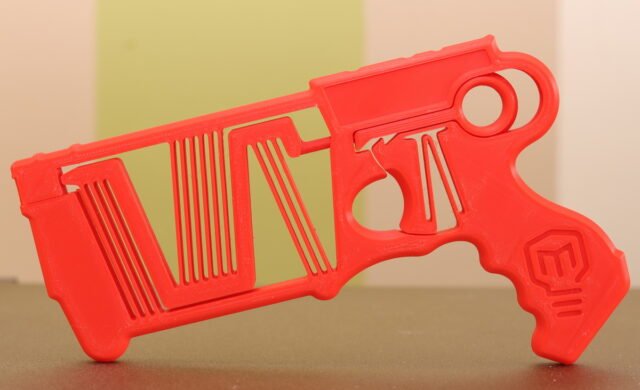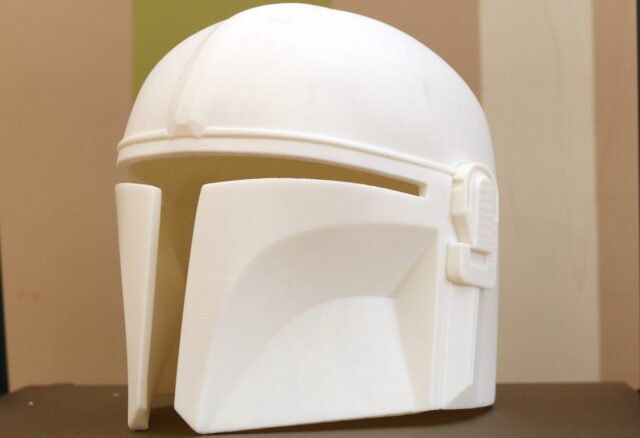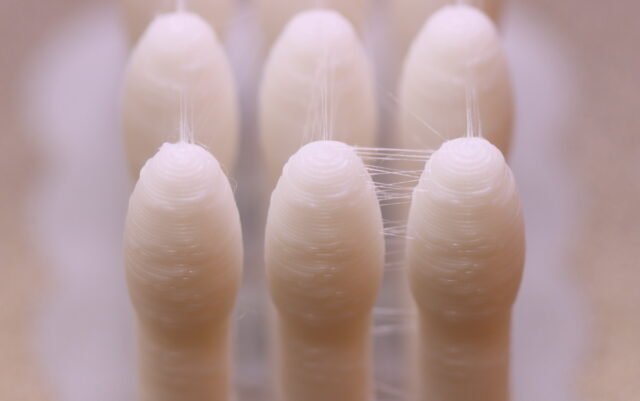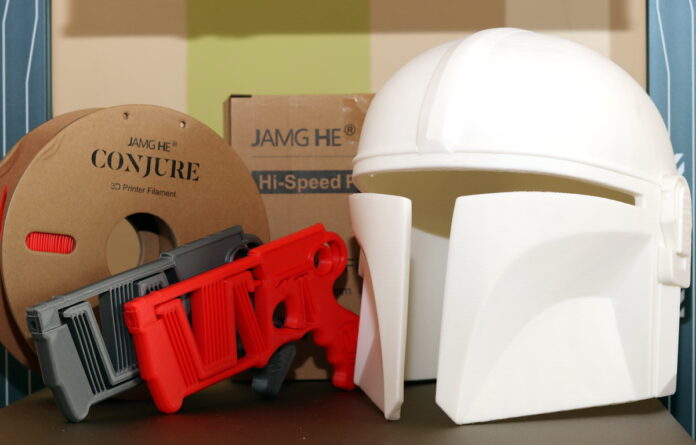Probably everyone into 3D printing hobby has already heard about the Chitubox slicing program. Still, in this review, we will focus on the company’s ChiTu JAMG HE Conjure PLA+ and Hi-Speed PLA Pus 3D filaments, which I had not heard until a few weeks ago.
To get the best out of our 3D-printed models, you must find the perfect balance between quality and speed. Printing speed is measured in mm/s and represents how fast the nozzle moves across the build plate. Based on my experience, slow printing speeds produce better quality results than high speeds when under-extrusion can occur. Standard PLA filaments are recommended to be used at 50-100mm/s. The Conjure PLA+ claims to be usable at up to 300mm/s and the HS PLA+ at up to 600mm/s.
Nowadays, 3D printer manufacturers promise crazy printing speeds, but the machine can reach that speed only during traveling moves. You can read marketing slogans like “Print 10X faster!” on printers that can print at 500mm/s. In the real world, a 500mm/s could finish the job only 1.5-4 times faster than a 50mm/s. 3D printing at high speeds only becomes “profitable” if you print large models. The warming time of a 3D machine, regardless of printing speed, is from a few minutes to a quarter of an hour or even more, depending on the size of the printed and heating power.
Conjure JAMG HE 3D filaments review
Disclosure: I received these high-speed 3D filaments in a product review collaboration with ChiTuSystems. Product specs and quality may vary according to the manufacturer’s reliability, so I cannot guarantee that you will get the material that performs the same as seen in my article.
Last month, ChiTu sent me eight spools of their high-speed ready JAMG HE 3D filaments (4x PLA+ and 4x HS PLA+). Both types were packed in the same kind of recycled cardboard box. ChitTu also opted for environment-friendly cardboard spoolers. As it should be, the filaments were in airtight vacuum bags with small silica gel sachets inside. Printing nozzle temperature, color, and manufacturing date are labeled on the bobbin. An unopened spool weighs around 1180 grams. Before use, it is recommended to scale your filament and note it so you can know the weight of the bare spool to calculate the remaining filament anytime.
I received White, Grey, Orange, Red, and Green filaments. All have a beautiful shade, pleasing to the eyes. The grey one has a nice metallic look. The diameter tolerance of the filaments is +/- 0.02 mm. During my tests, I had no issue with spool tangling or unwinding.
To test these Conjure PLA filaments, I used my high-speed Elegoo Neptune 4 Max printer, which is capable of printing up to 500mm/s and accelerating up to 8000mm/s. Besides reliability, another problem with HS printers is that they are damn loud. When it works overnight, I hear it through walls and closed doors in the apartment. Anyway, when I print huge designs that require 30-40 hours, I sleep like a rabbit, not because of the noise but because of the fear of print failure at 99%.
Testing the ChiTu Systems Conjure 3D filaments
Firstly, I tested the red HS PLA+ filament, printing a few compliant mechanism blasters. I started with 50mm/s, then 250mm/s, and lastly, 500mm/s. All printed well, and the quality was degraded very little. I used 220℃ nozzle temperature at low speed and 230℃ for high speed.

Secondly, I opened the grey Conjure High-Speed PLA+ and prepared the Mandalorian Helmet, which requires 925 grams of material and 32 hours to print if adequately sliced. Without supports, it needs 746 grams and 24 hours to print, respectively, with stock support settings, 1768 grams of filament, and 47 hours of job time. Unfortunately, the print failed after seven hours on the first attempt due to the filament’s quality problem. It was thicker on a portion of 5 mm (see photo below). It managed to go through the filament run-out sensor but stuck into the extruder.

I started the second attempt with my heart in my mouth. Luckily, this time worked perfectly till the end. When I could supervise the printer, I set 250mm/s mode, and when I slept or went to work, I printed at 100mm/s to reduce the chance of failure. The helmet came out amazingly with excellent and uniform layer adhesion; it just needs a little sanding and painting. The helmet’s ears had to be printed separately. Only a few windings were left on the bobbin when I finished them.

I tested the standard PLA+ only at normal speed (100mm/s) using 210℃ nozzle temperature. The filament performs well without any issues. When the time lets me, I will also test it at higher temperatures (260-280℃), where I should be able to print it at higher speeds (200-300mm/s). Unfortunately, with budget printers that can reach only 250-260℃ nozzle hotness, you can’t print at high speed with JAMG HE PLA+ filaments.

The stringing test print did produce a good result with only a few thin strings. Both Conjure filaments adhere well to the heated PEI sheet (60°C). The models didn’t pop off even after the print bed cooled down. I did NOT feel any odors during use.
Pricing, availability, and color options
When I published my review, the PLA Plus filament was available in packs of one or three spools starting from $15.99 with nine color options (Blue, Green, Orange, Red, Silver, Yellow, Grey, White, Skin, and Black). The High-Speed PLA+ can be ordered for $17.99/roll or $52.99/3 rolls, and you can also choose from nine colors. You can opt for China, USA, EU (including UK), or Australia warehouses. Chitu Systems Conjure filaments can also be ordered from Amazon.
Conjure Hi-Speed PLA highlights
- [Faster Printing] Specially designed to allow faster print speeds than regular PLA. The filament can move quickly through the printer, allowing fast and efficient printing. The Conjure HS PLA+ supports up to 600mm/s fast printing speed. It is compatible with Elegoo Neptune 4 Pro / Plus / Max, Bambu Lab P1P / X1 / X1C, AnkerMake M5, Creality K1 / K1 Max, Voron 2.4, FLSUN V400 / T1 / S1, Prusa, UltiMaker, MK3, Ender 3, MakerBot, Flashforge, Raise3D, and other HS 3D machines.
- [Standard PLA temperature] Does not require high nozzle temperatures. It can be used with standard (210-230℃) temperature settings regardless of print speed.
- [Improved Layer Adhesion] High-speed PLA 3d printing filament often exhibits better layer adhesion than regular PLA. This means the printed layers adhere more strongly to each other, resulting in stronger and more durable prints.
- [Increased Strength] HS PLA filament typically has improved mechanical properties, including increased strength and impact resistance. This makes it suitable for applications that require robust and durable prints.
- [Stronger toughness] High strength, strong rigidity, not easy to break.
- [Soft and colorful colors] Conjure HI-Speed PLA+ is available in nine colors, which are warm and soft.
- [Environmental protection] For environmental protection, we use paper trays. Non-toxic and biodegradable.
Conjure HS PLA+: Technical specifications
| Mechanical proprieties | |
| Dimensional Accuracy | +/- 0.02mm |
| Elongation at Break | 19.59±10% |
| Flexural modulus of elasticity | 2275±10% (MPa) |
| Tensile strength | 40.4±10% (MPa) |
| Maximum bending strength | 72±10% (MPa) |
| Izod notched impact strength | 183±10% (J/m) |
| Heat distortion temperature | 54ºC (0.45MPa) |
| Density | 1.23~1.31 g/cm3(25℃) |
| Melt index | 10.68g/10min (190℃, 2.16Kg) |
| 3D printing parameters | |
| Extruder Temperature | 200 -230ºC |
| Plate temperature | 55-60℃ |
| Printing speed | 50-450mm/s |
| Base plate | Glass/Carbon fiber, glued or 3M blue textured paper |
| Cooling fan | 100% |
Conjure PLA+ highlights
- [Improved Printability] PLA+ filament often has improved printability characteristics compared to regular PLA. It exhibits better layer adhesion, reducing the risk of delamination or splitting between printed layers. This results in stronger and more reliable prints with fewer structural flaws.
- [Dual-Temperature modes] Use 190-220℃ for 30-60mm/s or 260-280℃ for 200-300mm/s printing speeds.
- [Neatly Wound, Less Tangle] Full mechanical winding and strict manual inspection reduce tangles, snap, and line breakage issues.
- [Smooth printing] Conjure PLA+ has low shrinkage, less warping, and low odor and is easy to print.
- [Soft and colorful colors] Conjure PLA+ is available in nine colors, which are warm and soft.
- [Environmental protection] For environmental protection, we use paper trays. Non-toxic and biodegradable.
Conjure PLA+: Technical specifications
| Mechanical proprieties | |
| Dimensional Accuracy | +/- 0.02mm |
| Elongation at Break | 21.5±10% |
| Flexural modulus of elasticity | 1925±10% (MPa) |
| Tensile strength | 62±10% (MPa) |
| Maximum bending strength | 76±10% (MPa) |
| Izod notched impact strength | 6±10% (J/m) |
| Heat distortion temperature | 54ºC(0.45MPa) |
| Density | 1.23~1.25 g/cm3 (25℃) |
| Melt index | 5.5g/10min (190℃, 2.16Kg) |
| 3D printing parameters | |
| Extruder Temperature | 190-220℃ for 30-60mm/s 260-280℃ for 200-300mm/s |
| Plate temperature | 55-60℃ |
| Printing speed | 30-60mm/s at 190-220℃ 200-300mm/s at 260-280℃ |
| Base plate | Glass/Carbon fiber, glued or 3M blue textured paper |
| Cooling fan | 100% |
ChiTu Systems Conjure Hi-Speed PLA alternatives
While most 3D filaments offer PLA and PLA+ filaments, only a few have dedicated “High-Speed PLA” filaments. ESUN’s ePLA-HS (high-speed PLA) can be printed with up to 300-500mm/s (depending on your 3D machine), but the first layers must be extruded at 50mm/s. The ePLA-HS is available only in five colors and is priced at $18.99/kg.
The Raise3D Hyper Speed PLA is available for $36/spool in seven colors and supports speeds between 50 and 300mm/s.
Priced at only $14.99/kg, Elegoo’s Rapid PLA Plus filament is a budget alternative to the Conjure HS PLA+. You can choose from nine colors and print from 30 to 600 mm/s.
You Can Trust Our Reviews!
Since 2014, FirstQuadcopter has reviewed, thoroughly tested, and rated hundreds of products, including drones, gimbals, power stations, action cameras, 3D printers, and other high-tech gear to help you make better buying decisions.










I thought that the “high speed filament” story was just a marketing tool, but it really works at high speeds. I bought 5 spools after reading your review..
Since when did Chitu make filaments??? I’ve been using their slicer tool for years, but never heard about Chitu 3D printing materials…
Gyuri what slicer are you used for the helmet?
Stock Cura slicer from Elegoo!